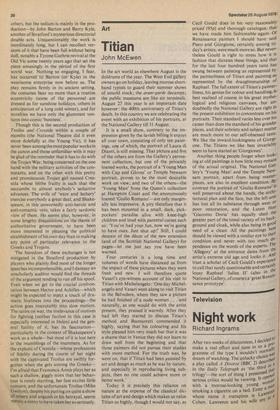Titian
John McEwen
In the art world as elsewhere August is the doldrums of the year. The West End gallery owners go on holiday, leaving morose shorthand typists to guard their summer shows of unsold stock; the avant-garde decamps; the public museums are like air terminals. August 27 this year is an important date however: the 400th anniversary of Titian's death. In this country we are celebrating the event with an exhibition of his portraits, at the National Gallery till 31 August.
It is a small show, contrary to the impression given by the lavish billing it enjoys all over town, consisting of only ten paintings, one of which, the portrait of Laura di Dianti, is still missing. That picture and five of the others are from the Gallery's permanent collection, but one of the privately loaned works, the portrait of a 'Young Man with Cap and Gloves' or Temple Newsam portrait, proves to be the most desirable work on view; and two of the others—the 'Young Man' from the Queen's collection at Hampton Court and the anonymously loaned 'Giulio Romano'—are only marginally less impressive. A pity therefore that it has been mounted in a small, dark, pickpockets' paradise alive with knee-high children and loud with parental curses such as: 'You've had your fun, now we're going to have ours. Just shut up!' Still, I could despair of the decor of the new extension (and of the Scottish National Gallery) for pages—let me just say you have been warned.
Four centuries is a long time and volumes of words have distanced us from the impact of these pictures when they were fresh and new. I will therefore quote Vasari's eye-witness account of his visit to Titian with Michelangelo: 'One day Michelangelo and Vasari went along to visit Titian in the Belvedere, where they saw a picture he had finished of a nude woman . . . and naturally, as one would do with the artist present, they praised it warmly. After they had left they started to discuss Titian's method and Buonarroti commended it highly, saying that his colouring and his style pleased him very much but that it was a shame that in Venice they did not learn to draw well from the beginning and that those painters did not pursue their studies with more method. For the truth was, he went on, that if Titian had been assisted by art and design as much as he was by nature, and especially in reproducing living subjects, then no one could achieve more or better work.'
Today it is precisely this reliance on nature at the expense of the classical dictates of art and design which makes us value Titian so highly, though I would not say. as Cecil Gould does in his very reasonably priced (95p) and thorough catalogue, that we have made him fashionable again. Of Renaissance painters I should have said Piero and Giorgione, certainly among today's artists, were much more so. But nevertheless Gould is right to stress how it is fashion that dictates these things, and that for the last four hundred years taste has swung between painting as represented by the painterliness of Titian and painting as represented by the draughtsmanship of Raphael. The full extent of Titian's painterliness, his genius for colour and handling. IS best realised of course in his great mythological and religious canvases, but undoubtedly the National Gallery are right in the present exhibition to concentrate on his portraits. Their standard varies less over his career than does the standard of his grander pieces, and their sobriety and subject matter are much more to our self-obsessed taste. We like the inward-lookingness of Giorgione. The Titians we like best invariably seem to have started as 'Giorgiones'. Another thing people forget when looking at old paintings is how little may remain of the actual original. The National Gallery's 'Young Man' and the Temple Newsam portrait, apart from being masterpieces, are also in excellent condition. BY contrast the portrait of 'Giulio Romano' !s well preserved about the hands, the architectural plan and the face, but the left arni has lost all its substance through wear or poor restoration, and the Luton H00 'Giacomo Doria' has equally shed the greater part of the tonal variety of its background and cloak, while also being in pod need of a clean. All the paintings here should he viewed with a similar eye to their condition and never with too much dependence on the words of the experts. The 'Allegory' at the entrance dates from the, artist's extreme old age and looks it. .M° trust a scholar of Cecil Gould's experie.na
to call that surely questionable and certainlY
lousy Raphael 'Julius II' (also th.e National Gallery, of course) a 'great Renals sance prototype'.


























 Previous page
Previous page